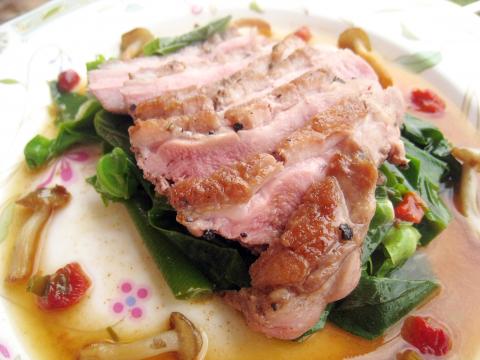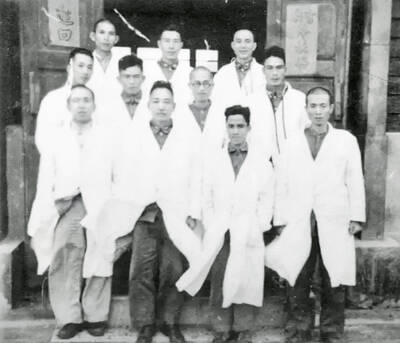I had never thought that eating bird’s nest fern (山蘇) was even a possibility until I came to Taiwan. This is a plant that is probably familiar to someone who has lived in Southeast Asia, but more likely as an ornamental plant than part of a living larder. It features strongly in the cuisine of local Aboriginal tribes, and has recently crossed over into the mainstream with considerable success. Although it’s now often cultivated for commercial sale, it still remains something of an exotic, retaining its “foraged” cred.
In my early and tentative exploration of Taiwan’s culinary culture, I bought into the idea that these foraged vegetables required special skills to prepare well. I enjoyed eating bird’s nest fern in restaurants that specialized in “wild” food, secure in the knowledge that preparation of this exotic morsel was best kept in the hands of specialists. After moving to Hualien, I was again confronted with the fern, and thought I would give it another chance. And it proved yet an eye opener. A little bit of care with washing the leaves and cutting away the more fibrous stems, and then there is no mystery at all. While not remarkably flavorful, they provide a lovely crisp crunch and are great for carrying other strong flavors.
One of the most common preparations of bird’s nest fern is fried together with salted dried anchovies and preserved cordia dichotoma (破布子). This preparation is widely available in restaurants and is a perfect accompaniment to a Taiwanese seafood meal.

Photo by Ian Bartholomew
The first thing to know about bird’s nest fern is to check that the leaves are perfectly green and have not been burnt by too much sunlight. The edible portion of the plant are the tender shoots, which are easily damaged, and when shopping at the market, you want to look for the deep and unblemished emerald green that really glistens on the plate.
Bird’s nest fern bought at the supermarket has usually been cleaned to some degree, but if purchased from a traditional market, it is best to check the leaves carefully, wiping off dirt and bugs that may adhere to the leaves — which will not be removed by a simple wash of water. As the texture is best with only a very rapid cooking, it is also advisable to cut away some of the thicker veins at the center of the leaf.
Blanching the leaves in salted water helps hold the lovely green color in any subsequent preparation. If you really want to keep things simple, just take the blanched leaves and top them with some mayo or a lighter dressing of sesame oil and soy, and you have a dish ready to go. They are also very nice deep-fried in a light batter.

Photo by Ian Bartholomew
In Taiwan, bird’s nest fern was traditionally considered a “mountain” vegetable, and therefore generally free from the worst excesses of chemical pesticide use. It is now widely grown in the plains as a secondary crop to betel nut by small scale farmers, which cannot but be a good thing. The plant has various uses as an herbal remedy in Southeast Asian folk medicine, thought to be a diuretic that is beneficial for bladder complaints. In Taiwan, it is widely thought of as having qualities that assist in the prevention of cancer.
While these claims await more scientific corroboration, as a wild vegetable that has yet to be subject to the tender mercies of agribusiness, bird’s leaf fern, if probably remarkably free of unwelcome tampering and is one of the healthiest veg options on the market right now. It is rich in calcium, iron and zinc, is a good source of protein and dietary fiber, and with its interesting texture, will also put some variety into your meals.
Bird’s Nest Fern with Duck Breast, Caper and Sweet Pepper Sauce
Recipe
(serves two)
Getting a crispy skin on a duck breast is best done by starting with a cold skillet and cooking over low heat to render the fat. That’s all good and well, but as we all know, the fat is where the flavor is, so what better than to use the oils and pan juices to make a sauce to flavor the meat and accompanying vegetables. Bird’s nest ferns provide this dish with a lovely crunch (make sure not to overcook them), and by blanching them they retain their vibrant green coloring.
Ingredients
2 small duck breasts (about 150g to 200g each)
Salt and pepper
Vegetable oil
1 small bunch of bird’s nest fern
1/4 cup white wine
1/2 tsp paprika
10 capers (in brine)
1/2 sweet red pepper, roasted and marinated (recipe follows)
Half a packet of white beech mushrooms
(鴻喜菇)
Salt and pepper / Method
1. Take the duck breast out of the refrigerator and allow to reach room temperature. About 1 hour.
2. Prepare the bird’s leaf fern by first washing the leaves thoroughly and cut away the thickest stems and discard.
3. Bring a pot of lightly salted water to a boil and blanch the leaves for about 1 minute. Remove from water and drain. Set aside.
4. Take the duck breast and score the fat in a hatch pattern with a sharp knife. This will help the fat render. Season liberally with salt and pepper.
5. Put about a teaspoon of vegetable oil in a cold pan. Place the duck skin-side down in the pan, smearing the oil. Turn to a low heat and cook slowly without moving the duck, though pressing down on the edges to make sure the whole skin is pressed against the pan.
6. Cook until internal temperature reaches 46 degrees Celcius, about 20 minutes, by which time the skin should be crisp and golden (cooking time will vary considerably depending on the size of the breast). Turn over and cook the meat side for about 2 to 3 minutes, bringing the temperature to 52 degrees Celcius. Remove from pan and rest for at least 5 minutes.
7. While the duck is cooking, mince the capers and roughly chop the roasted red pepper.
8. Heat oil in a large frying pan over medium heat. Throw in the mushrooms, making sure not to crowd the pan. Sprinkle with sea salt. Fry, stirring occasionally, until the mushrooms get a nice burnish of golden brown.
9. Pour off excess oil from the pan used to cook the duck, retaining about 3 tablespoons. Bring to medium heat and deglaze the pan with white wine, using a wooden spoon to free up any bits stuck to the base (there is loads of flavor in these often neglected brown bits at the bottom of the pan).
10. Reduce by about half. Throw in the capers and red peppers. Add the blanched bird’s nest fern and paprika. Stir over medium heat to coat the leaves.
11. Place the bird’s nest fern on the plate. Thinly slice the duck breast and place over the vegetables. Pour over the remaining liquid and garnish with the mushrooms.
For the red peppers
There are many ways of removing the membrane from the bell pepper from steaming to toasting over an open flame. If you have an oven, roasting is probably the least troublesome, and also provides a lovely smoked quality to the flavor. Using a broiler is quicker, but you really have to be on top of the process in case the peppers don’t just char, but burn right through.
Ingredients
1 large or 3 small bell peppers
1/2 cup rice vinegar
1 tbsp salt
Olive oil
Directions
1. Preheat the oven to 220 degrees Celsius.
2. Wash the peppers thoroughly and place on a baking sheet.
3. Place in the top third of the oven. Cook for 20 minutes and rotate. Cook for another 20 minutes. The skin should be blackened and puffy.
4. Remove from the oven and cover with foil, allowing the peppers to cool gradually in their own steam. This greatly facilitates the process of removing the skin.
5. Peel off the thin outer membrane and remove the seeds. Do not wash the peppers at this point, as this will remove much of the flavor.
6. Put the vinegar in a bowl. Prepare another bowl or storage jar. Have the salt standing by ready to use.
7. Dredge the pieces of bell pepper in vinegar and then lightly salt. Place in the prepared jar. Do this will all the peppers. Discard the excess vinegar. You should have some liquid remaining from the cooked and peeled peppers. Pour this over the salted peppers. Add olive oil to top up and cover.
Ian Bartholomew runs Ian’s Table, a small guesthouse in Hualien.
He has lived in Taiwan for many years writing about the food scene and has decided that until you look at farming, you know nothing about the food you eat. He can be contacted at Hualien202@gmail.com.

That US assistance was a model for Taiwan’s spectacular development success was early recognized by policymakers and analysts. In a report to the US Congress for the fiscal year 1962, former President John F. Kennedy noted Taiwan’s “rapid economic growth,” was “producing a substantial net gain in living.” Kennedy had a stake in Taiwan’s achievements and the US’ official development assistance (ODA) in general: In September 1961, his entreaty to make the 1960s a “decade of development,” and an accompanying proposal for dedicated legislation to this end, had been formalized by congressional passage of the Foreign Assistance Act. Two

March 31 to April 6 On May 13, 1950, National Taiwan University Hospital otolaryngologist Su You-peng (蘇友鵬) was summoned to the director’s office. He thought someone had complained about him practicing the violin at night, but when he entered the room, he knew something was terribly wrong. He saw several burly men who appeared to be government secret agents, and three other resident doctors: internist Hsu Chiang (許強), dermatologist Hu Pao-chen (胡寶珍) and ophthalmologist Hu Hsin-lin (胡鑫麟). They were handcuffed, herded onto two jeeps and taken to the Secrecy Bureau (保密局) for questioning. Su was still in his doctor’s robes at

Last week the Democratic Progressive Party (DPP) said that the budget cuts voted for by the China-aligned parties in the legislature, are intended to force the DPP to hike electricity rates. The public would then blame it for the rate hike. It’s fairly clear that the first part of that is correct. Slashing the budget of state-run Taiwan Power Co (Taipower, 台電) is a move intended to cause discontent with the DPP when electricity rates go up. Taipower’s debt, NT$422.9 billion (US$12.78 billion), is one of the numerous permanent crises created by the nation’s construction-industrial state and the developmentalist mentality it

Experts say that the devastating earthquake in Myanmar on Friday was likely the strongest to hit the country in decades, with disaster modeling suggesting thousands could be dead. Automatic assessments from the US Geological Survey (USGS) said the shallow 7.7-magnitude quake northwest of the central Myanmar city of Sagaing triggered a red alert for shaking-related fatalities and economic losses. “High casualties and extensive damage are probable and the disaster is likely widespread,” it said, locating the epicentre near the central Myanmar city of Mandalay, home to more than a million people. Myanmar’s ruling junta said on Saturday morning that the number killed had